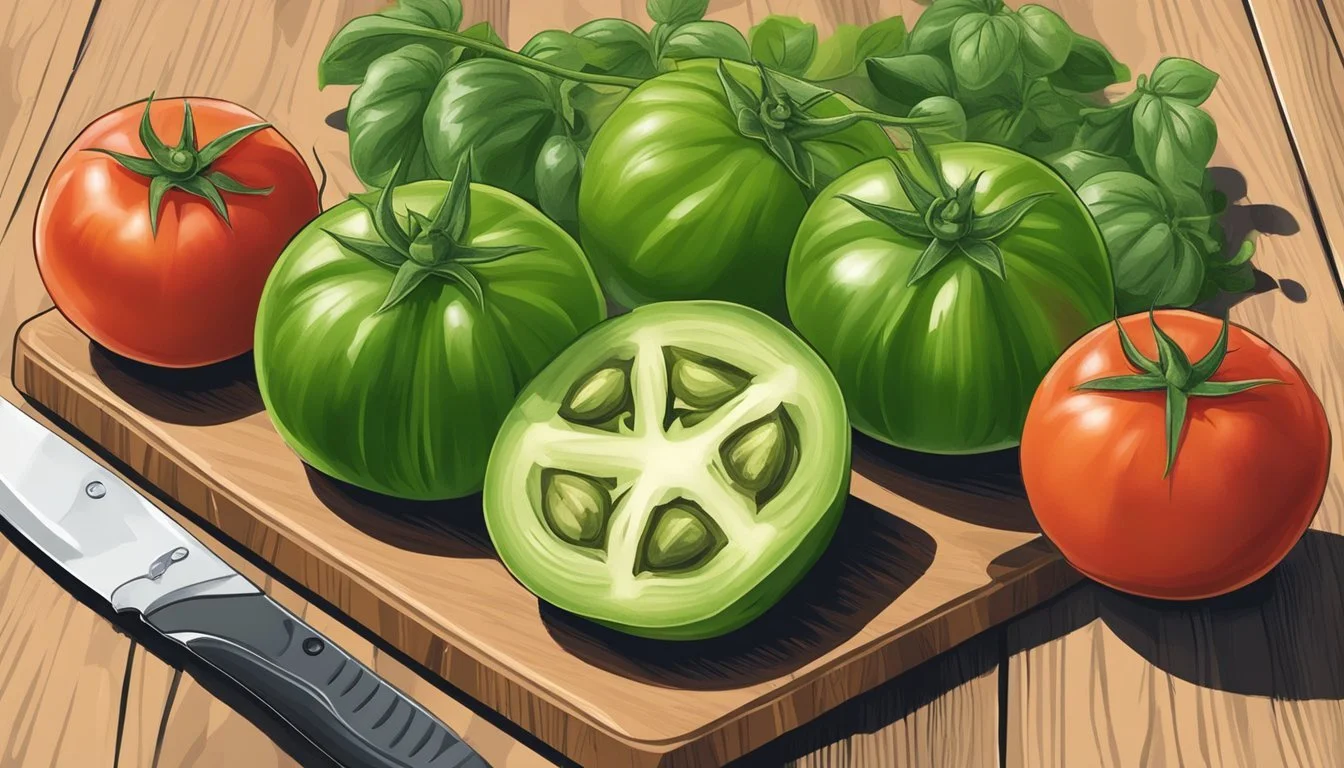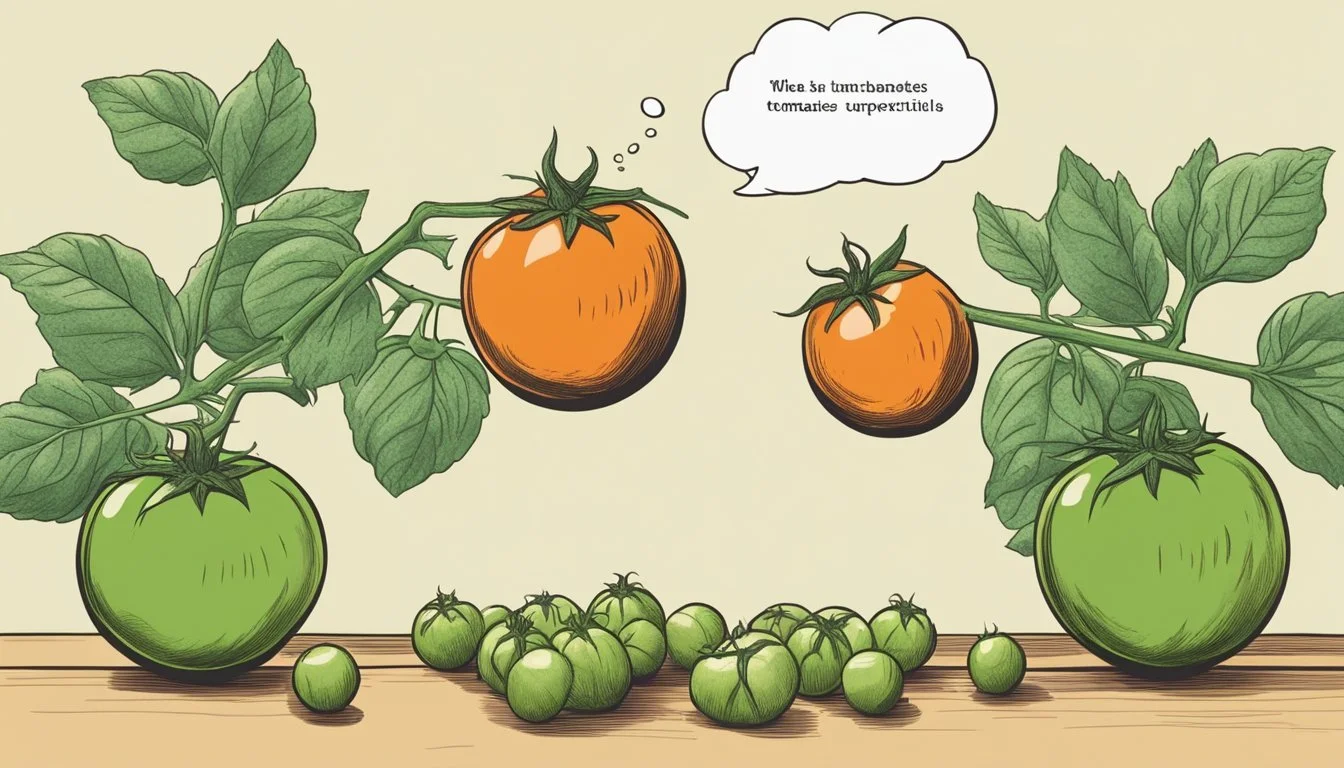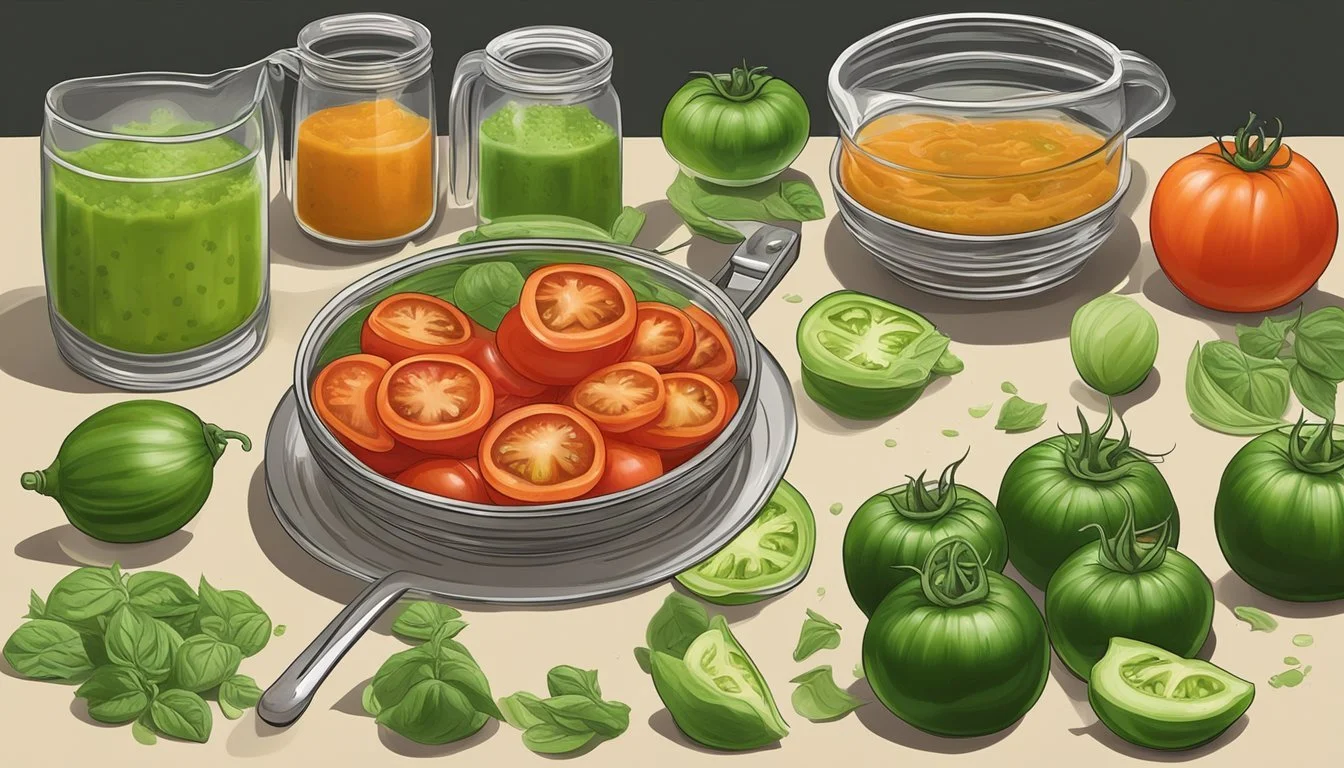How to Substitute Unripe Tomatoes for Tomatillos
A Simple Switch Guide
When faced with the lack of tomatillos for a recipe, unripe green tomatoes (What wine goes well with tomatoes?) emerge as the leading substitute due to their similar texture and tartness. A fundamental ingredient in Mexican cuisine, tomatillos impart a unique flavor to dishes such as salsa verde and soups. However, their availability can be limited outside of their growing season or geographic region. In these instances, unripe green tomatoes stand as an accessible and effective replacement, bringing a comparable acidic punch to culinary creations.
To harness the flavor of green tomatoes as a tomatillo substitute, one might consider adding a dash of lime juice to match the bright zestiness of tomatillos. They are particularly firm and less juicy than their ripe counterparts, which can be advantageous in recipes that require the structural integrity of the fruit to remain intact throughout the cooking process. By using green tomatoes in equal measure to tomatillos, cooks can achieve a balance of flavor and texture in their dishes.
Whether simmered into stews or blended into salsas, green tomatoes adapt well to the roles typically filled by tomatillos. Adjusting the preparation and cooking time with this substitution may be necessary, as green tomatoes tend to be denser and require longer to soften. Enthusiasts of authentic flavors need not be deterred by the absence of tomatillos; with the correct adjustments, green tomatoes can be transformed into a worthy stand-in for many recipes.
Understanding Tomatillos
When cooking with tomatillos, it's important to appreciate their unique characteristics and versatility in various recipes. This section aims to provide a detailed understanding of tomatillos, including their definition, nutritional aspects, and roles in culinary endeavors.
Defining Tomatillos
Tomatillos, scientifically known as Physalis philadelphica, are a small, round fruit encased in an inedible husk. A member of the nightshade family, they are close relatives to tomatoes, but they are distinct in their appearance and taste. Upon maturity, the husk turns brown and splits open, revealing the green fruit inside which is ready to be harvested.
Nutritional Value
Tomatillos are low in calories but rich in essential nutrients. They provide:
Vitamins: High in vitamin C and vitamin K.
Minerals: Contains potassium and manganese.
Antioxidants: The green color indicates the presence of valuable antioxidants.
While their nutritional value supports various health aspects, it is their distinctive flavor that makes them a staple in culinary use.
Culinary Uses
In Mexican cuisine, tomatillos are a fundamental ingredient. They impart a slightly sweet and tart flavor, which is a signature in dishes such as Salsa Verde and Chicken Posole. Typically, they are used raw, boiled, or roasted, allowing their subtle citrus-like taste to shine through. The tartness of tomatillos brings a vibrant and fresh profile to recipes, increasing their culinary demand.
Identifying the Need for Substitutes
When cooking dishes that traditionally feature tomatillos, one may encounter situations where a substitute is necessary. These include issues related to availability or dietary restrictions due to allergies.
Tomatillo Availability
Tomatillos are not always accessible in every supermarket, particularly outside of regions where Mexican cuisine is prevalent. This green, husk-covered fruit is a staple in Latin American dishes, prized for its tart flavor and rich in potassium and antioxidants. When tomatillos are out of season or absent from local grocery stores, cooks need to identify appropriate substitutes that can mimic the distinct qualities of these fruits without compromising the dish's integrity.
Supermarkets may lack tomatillos due to:
Seasonal Variability
Regional Availability
Allergic Reactions
Although rare, some individuals may experience allergic reactions to tomatillos. Allergies can manifest as mild to severe symptoms and those affected require a safe alternative to avoid health complications. Substitutes for tomatillos should provide a similar nutritional profile, including levels of potassium and antioxidants, while being hypoallergenic to ensure the well-being of sensitive consumers.
Considerations for allergy sufferers:
Substitute must be hypoallergenic
Nutritional content should align with tomatillos
Choosing the Right Substitute
When substituting for tomatillos, it's crucial to select ingredients that mimic the unique tangy flavor and firm texture of the original.
Using Green Tomatoes
Unripe green tomatoes are an excellent substitute for tomatillos due to their similar acidity and firmness. To best replicate tomatillos' flavor profile, one should opt for green tomatoes that have not yet begun to show any red or yellow hues, ensuring they remain tart rather than sweet. A splash of lime juice may be added to green tomatoes to enhance their sour notes, making them particularly suitable for Mexican dishes such as salsas and sauces.
Other Fruit Substitutes
Cherry tomatoes can be utilized when a sweeter alternative is acceptable. These small, bright green to red fruits offer a hint of the acidity found in tomatillos but with an increased sugar level. Gooseberries, on the other hand, share a similar sourness to green tomatillos, making them a viable substitute in many recipes. One must consider the ripeness and color of these fruits, as varied hues—ranging from green to purple—can indicate different levels of sweetness and tartness.
Vegetable Alternatives
Vegetables like green bell peppers (green peppers) might be used for their crunchy texture, though they lack the tartness of tomatillos. In dishes where texture is more important than the exact flavor profile, such as stews and stir-fries, green bell peppers serve as a suitable alternative. They provide a bright green color that visually resembles the appearance of tomatillos without the characteristic sourness.
Preparation Methods
Substituting unripe tomatoes for tomatillos involves specific techniques to mimic the tart, citrusy profile of tomatillos. The goal is to achieve a balance in flavor and texture comparable to the original ingredient.
Prepping Green Tomatoes
When preparing green tomatoes as a stand-in for tomatillos, they should first be washed and then sliced or chopped according to the recipe's requirements. For salsa or similar raw applications, it is essential to add a splash of lime juice to impart the necessary sour taste. If the goal is to use them in cooked dishes, such as enchiladas or sauces, pre-cooking the tomatoes slightly can be beneficial. This can be done by roasting or grilling to enhance their flavor and add a smoky note that complements their innate tartness.
Roasting: Place sliced green tomatoes on a baking sheet and roast in a preheated oven at 375°F (190°C) until they begin to soften and char slightly, typically for about 15-20 minutes.
Grilling: Grill sliced green tomatoes over medium heat until they exhibit char marks and their texture begins to yield, usually for 4-5 minutes per side.
Prepping Other Substitutes
When using substitutes other than green tomatoes, such as green peppers or green chilies, the method of preparation will vary slightly.
Green Peppers: To use green peppers as a stand-in, they should be diced and can be used fresh for a crisp, slightly spicy alternative, or they can be sautéed to soften their texture.
Green Chilies: If opting for green chilies, such as Anaheim or poblano peppers, they can be roasted or grilled to enhance their flavor and add smokiness. After roasting, they should be peeled and seeded before being chopped.
For both alternatives, adding lime juice or tamarind paste can help achieve a citrusy note to replicate the tanginess of tomatillos. It's important to consider the varying levels of heat and sweetness these substitutes might bring to the dish and adjust the quantities accordingly.
Cooking Techniques
When substituting unripe tomatoes for tomatillos in green sauces such as green salsa or salsa verde, the cooking techniques employed can significantly influence the outcome in terms of flavor and texture.
Simmering Substitutes
Simmering unripe tomatoes is useful when preparing sauces and salsas. To create a vibrant salsa verde, one can simmer chopped unripe tomatoes with ingredients like onions, garlic, and hot peppers. The tomatoes should be simmered until they break down and meld flavors with the other components, typically taking about 20-30 minutes.
Salsa: Simmer for 20 minutes until soft.
Sauces: Cook slowly to integrate flavors.
Roasting for Depth of Flavor
Roasting unripe tomatoes can enhance their natural flavors and bring a depth similar to roasted tomatillos. For green sauces and salad dressings, the tomatoes can be halved and placed cut side down on a baking sheet, then roasted at 425°F (220°C) until they start to char, which usually takes about 15-20 minutes.
Temperature: 425°F (220°C)
Time: 15-20 minutes until slightly charred.
Roasted green peppers may also be added to the mix to introduce a more complex, smoky profile to the sauce.
Grilling for Smokiness
Grilling unripe tomatoes imparts a smoky flavor akin to what one would expect from grilled tomatillos. For grilled salsas or green sauces, the tomatoes should be grilled over medium-high heat, turning occasionally until they display grill marks and softened flesh, generally about 10-12 minutes.
Grill setting: Medium-high heat.
Duration: 10-12 minutes, turn occasionally for even charring.
Flavor Adjustments
In substituting unripe tomatoes for tomatillos, one must be mindful of achieving the desired balance of tartness, tanginess, and sweetness. These adjustments ensure the tomatoes mimic the distinct flavor profile of tomatillos.
Enhancing Tartness
To reinforce the inherent tartness of unripe tomatoes, one can add lime juice to the dish. Lime has a citrusy zing that closely resembles the zesty flavor of tomatillos, making it an ideal addition.
Recommended Ratio: For every cup of chopped unripe tomatoes, add 1 tablespoon of lime juice.
Balancing Tanginess
Unripe tomatoes can possess a tangy undertone. To balance this tanginess while cooking, a splash of lemon juice may be introduced. It subtly complements the tomatoes without overpowering them.
Lemon Juice: Use sparingly, adding just a teaspoon at a time and tasting as you go to preserve the balance.
Adding Sweetness
Whilst tomatillos carry a sweet and tart flavor, unripe tomatoes may lack this complexity. To add sweetness, a small measure of sugar can be sprinkled in during preparation.
Sugar Adjustment: Begin with 1/2 teaspoon of sugar per cup of tomatoes and adjust according to taste.
Incorporation into Recipes
When substituting unripe tomatoes for tomatillos in various dishes, the key is to preserve the unique tangy flavor profile typically provided by tomatillos, while also considering adjustments in texture and cooking times.
Salsa and Sauce Applications
For salsa verde or Mexican salsa verde, one can dice unripe tomatoes and combine them with ingredients like onions, cilantro, and chili peppers. To mimic the tartness of tomatillos, add a squeeze of fresh lime juice. The texture may be less juicy, but the flavor will be close to the original.
Salsa: Replace tomatillos with chopped unripe tomatoes, lime juice, and salt.
Sauce: Puree unripe tomatoes with green chilies for a tangy and spicy sauce base.
Soups and Stews
Unripe tomatoes can be incorporated into soups and stews after they've been roasted to enhance their flavor. The tomatoes add the necessary acidity and fleshiness to soups like Mexican chicken pozole or vegetarian chili, (What wine goes well with vegetarian chili?) thus complementing the other ingredients without overpowering them.
Soup: Roast and puree unripe tomatoes for a base in chicken or vegetable soups.
Stew: Dice and simmer unripe tomatoes in stews to provide a satisfying consistency and tangy taste.
Main Dishes and Sides
In main dishes like tacos, enchiladas, and chilaquiles, chopped unripe tomatoes serve well as a tomatillo substitute. For sides such as quesadillas or nachos, use unripe tomato-based salsa or sauces as a topping or dip.
Mexican dishes: Substitute with unripe tomatoes in recipes calling for cooked tomatillos.
Tacos and enchiladas: Use a unripe tomato and lime mixture as a filling or topping.
Chilaquiles: Blend unripe tomatoes with green chilies for the sauce to coat the tortillas.
Roasting or grilling the unripe tomatoes before adding them to these dishes can intensify their flavors, similar to the smokiness of grilled tomatillos.
Preservation and Storage
When substituting fresh tomatillos with unripe tomatoes, understanding the correct preservation and storage methods ensures they maintain quality and flavor for future use.
Storing Substitutes
Unripe tomatoes, serving as a stand-in for tomatillos, should be stored at room temperature until they have reached the desired firmness. Once they achieve this state, storage involves:
Refrigeration: Place them in the crisper drawer of the refrigerator.
Temperature: Keep between 12°C to 15°C (55-60°F).
Humidity: Maintain relative humidity levels of 85% to 90% for optimal preservation.
Paper Bag: Wrapping unripe tomatoes in a paper bag can help in maintaining the appropriate humidity level.
Shelf-Life: Follow these steps, and unripe tomatoes can be kept fresh for approximately 2 to 3 weeks.
Preserving for Later Use
For extending the shelf life of unripe tomatoes beyond refrigeration:
Canning: This method suits those looking to prepare canned tomatillos at home using tomatoes; can them in a vinegar solution or as salsa.
Sterilization: Ensure jars and lids are sterilized before canning.
Acidity: Adjust the acidity appropriately to prevent spoilage.
Freezing: Cut tomatoes into quarters or slices and freeze them. This method is ideal for later use in jams or salads.
Pickling: Mix vinegar, water, sugar, salt, and spices; bring to a boil. Pour over cut tomatoes and seal in jars. Pickled substitutes can be stored in the refrigerator for up to four weeks.
By adhering to these specific preservation techniques, canned vegetables such as tomatoes can be used interchangeably with fresh or canned tomatillos in various Mexican green tomato dishes.
Understanding Traditional and Modern Applications
When substituting unripe tomatoes for tomatillos, it is crucial to consider the role tomatillos traditionally play in Mexican cuisine and how modern adaptations can effectively use tomatoes to achieve similar culinary results.
Traditional Uses in Mexican Cuisine
In traditional Mexican dishes, the tomatillo, also known as the Mexican husk tomato, has been a staple ingredient long before the Aztecs. A member of the nightshade family, it is related to the tomato and is also known as a ground cherry. Tomatillos impart a unique tart and lemony flavor that is foundational in creating the authentic taste of various Mexican dishes. They are a key component in sauces such as salsa verde and are commonly used in recipes for tacos, enchiladas, and guacamole.
Salsa Verde: A classic sauce made with tomatillos, typically blended with ingredients like chili peppers, onions, and cilantro.
Enchiladas: Often feature a tomatillo-based green sauce poured over rolled tortillas filled with meat or cheese.
Guacamole: Occasionally includes tomatillos for added zing.
Contemporary Adaptations
In modern cooking, when tomatillos are not readily available, unripe green tomatoes serve as a pragmatic substitute to mimic the sour flavor profile of tomatillos. Although not identical in taste, green tomatoes can be modified to approximate the acidity and fruitiness of tomatillos through the addition of lime juice. They are most effective in applications where the tomatillo's presence is complementary rather than central.
Taco Toppings: Diced green tomatoes with a squirt of lime can be an innovative topping.
Modern Twists on Salsas: Create a refreshing salsa with a mixture of green tomatoes, fresh herbs, and citrus.
Salads: Green tomatoes can add crunch and a pleasant sourness to salads, providing a contrast to other ingredients.
Health Considerations and Dietary Restrictions
When substituting unripe tomatoes for tomatillos in recipes, it's important to consider their nutritional profile and potential allergen information, as they can impact dietary restrictions and health goals.
Caloric and Nutrient Content
Unripe tomatoes offer a similar low calorie option as tomatillos do, which can be favorable for weight management. They contain essential nutrients that contribute to a healthy diet. To give a specific comparison:
Tomatillos: A half-cup serving holds approximately 21 calories and is a source of antioxidants, vitamins, and minerals, particularly potassium.
Unripe Green Tomatoes: Also low in calories, green tomatoes contain vitamins and nutrients but may require longer cooking times, which could potentially affect nutrient retention.
Allergen Information
Both tomatillos and unripe tomatoes are generally free from common allergens, making them a safe substitute for many individuals with dietary restrictions. It is, however, crucial to note that:
Allergic Reactions: While rare, one can experience allergic reactions to any type of food, including tomatillos and unripe tomatoes. Always advise individuals with food sensitivities to exercise caution.
Dietary Restrictions: These vegetables are compatible with most dietary restrictions, but one should still verify individual dietary needs and concerns, such as low-potassium diets where the potassium content might be a consideration.









